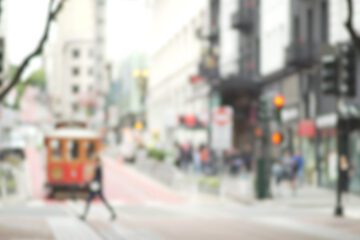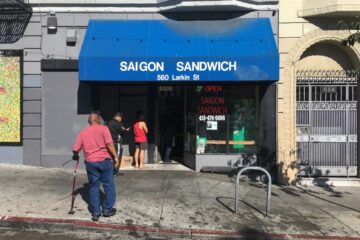The Fight Over The Great Highway Gets Messy
The Great Highway is messier than we realized, and we’re not just talking about the sand that piles up and closes the area for maintenance 32* times a year. Prop K, a ballot measure about closing the stretch of road between the Pacific Ocean and the Outer Sunset, is dredging up all sorts of feelings.
The stretch between The City and the Pacific Ocean is, by all accounts, iconic. Andy Olive, a lifelong resident and small business owner who is raising a family in the Sunset, shares a funny memory of the Great Highway: “One day I was standing on the middle divider waiting for traffic to cross the street and go surf and my mom drove by on her way to work, honking at me and just with this look on her face like, ‘You’re in big trouble!’ I still went surfing since the waves were good but yeah, I got into big trouble.”
The Great Highway’s Recent History
For decades, teen surfers could have experienced similar stories along the Great Highway. But then in 2020, things got quiet. That’s when The City decided to pilot road closures. One of those? The Great Highway. And a few months ago, Olive says he was surprised because he thought the pilot of only closing on the weekends was a great compromise. “It felt like [Prop K] just appeared on the ballot,” he says, noting that there wasn’t much community outreach.
The pilot expires in 2025. Prop K, on the ballot this November, allows for further experimentation with the added stability of a permanent closure. Lucas Lux, campaign manager for Yes on K and also the president of the board of Friends of Great Highway Park, explains that the 2020 pilot project “completely changed life for Outer Sunset residents by opening up this community space where we could meet and be together with all of our neighbors.”

Let’s Back Up
How did this land come under Rec and Parks jurisdiction? Before there was a Great Highway, there was the idea of Golden Gate Park. Its designers wanted to change miles of sand dunes into a public recreational area “clothed with a thrifty forest” of trees. That involved making a huge fence of redwood posts, waiting for dunes to encroach, and then making another fence on top until the anchoring sea grasses grew in and held things down (literally). The question asked in 1870 continues today: What to do about the land between the city and the ocean?
During this period, there were very few (human) residents in what’s now known as the Sunset neighborhood south of the park. Most visitors to Ocean Beach came up from The City for Sunday picnics. With time, that neighborhood filled in. But back in 1873, the Park Commission saw the potential. They wanted the whole stretch to be “more than just an auxiliary to the park.”
Whether they anticipated (or cared much about) pollution, traffic, access, development, surfing, or much beyond recreation is unclear. They did have to deal with squatters and an illegal saloon on the beach. But that’s how the land came to be under the umbrella of Rec & Parks, where it still lives today. Why does that matter? Prop K is going to tell Rec & Parks what to do next with the land.
Foredunes (sounds kinda dirty, huh? Well it is. It’s sand.)
Even in the 1870s, it was clear that mitigating the ever changing sand would be an issue. Reports from the 1930s to the 1990s confirmed it. “With time, the beach from Noriega Street south will recede,” says the Army Corps of Engineers in April of 1991, couching their vague estimate with the caveat that it’s unclear exactly when because the rate of erosion varies so greatly.
Today, the debate around what to do is fervent and the whole city is involved, but once again we find that nothing in San Francisco’s ever new-new. A 1978 article called Corrective Surgery for the Great Highway describes a similar dynamic in public commentary around traffic, stating that the public “held varying and somewhat contradictory viewpoints on the road… factions formed and the proponents of each scheme in turn attempted to win over city officials and the designers.” Gee, can you believe nearly fifty years have elapsed between then and now?
Prop K is only one piece of the puzzle. There are parts of the Great Highway that will close; that’s already been decided. From Sloat down to Skyline, climate change has made it necessary to reroute traffic and transform that portion of the Great Highway. Prop K doesn’t deal with the section that sits between the nation’s greatest park and the ocean.

For It, Against It
Matt Lopez, a Sunset resident and business owner, has lived in San Francisco his whole life. He’s been surfing on Ocean Beach since he was eight years old; he still surfs 10-15 hours a week depending on the time of year. He says during the pandemic when the pilot project happened, “It was a pain in the ass… I really hope (Prop K) doesn’t pass.”
Much of the debate centers on three issues: funding, traffic, and pollution.
Where’s the Money?
Lopez says, “They call it turning the Great Highway into a park, but there is no park. There’s no money for a park. A shut-down road isn’t a park.” In the meantime, Lopez thinks it’ll hurt the working class while benefiting what he calls the Laptop Elite who work from home. He explains, “It’s a socioeconomic issue. The laptop elite that work from home, it doesn’t affect them so they don’t think it’s a problem.”
The Office of the Controller says the measure will save the city in not only capital (like longer-term planning) but also daily maintenance like moving the sand off the road for commuters. Lux explains that while Prop K doesn’t commit the city to a longer-term park redesign or funding plan, it will “invite more people out with low cost improvements like adding benches, art, the type of stuff that you see on JFK Promenade.” Lux thinks road closure is only the first step; if it passes, the area will be subject to the same capital planning process as any other land that Rec & Park manages.
Traffic Jams
Olive, the Sunset resident who got caught being delinquent as a teen, says these days he uses the Great Highway to drive his own kids to and from school “as a calming way to transition into or out of the day.” During the week, that’s still possible, but Prop K will close it full time.

SFMTA’s report describes why speed control elements were introduced in detail here. But Lopez argues, “When you’re a working class individual that has to drive five days a week to a stressful job and then you have to sit in traffic while rich people cruise around on their e-bikes, it’s pretty insulting.” Lopez claims that SFMTA’s data is wrong, saying, “They slowed down the timing of the lights from 35 miles an hour down to 27 miles an hour so they’ve skewed the statistics on travel time.”
Now, Lopez says his commute is far worse. On the weekends, the surfer has to drive through the neighborhood. He says it’s confusing and way slower, plus now, “People are going 60 down these [residential] roads.” But putting the weight of alternate routes on the shoulders of Rec & Park is challenging because this prop is solely about one stretch of road they manage, while other potential thoroughfare improvements would need to involve SFMTA.
In the Air
In the meantime, pollution is a hot, smoggy topic too. Lopez says, “They’re increasing pollution by diverting cars off a straightaway into The City.” He argues that drivers will drive regardless, so this project only makes them drive longer (and therefore pollute more).
Meanwhile, Prop K has racked up endorsements from the Sierra Club, Golden Gate Bird Alliance, and the SF League of Conservation voters. In an SFEI (Estuary Institute) report shared with us by Lux, researchers describe other benefits like reducing noise and light pollution that harms birds and other critters on Ocean Beach.
Lux argues, “Doing nothing is not an option. We have to rethink how we use our coastal space and how we can prioritize the health of our dunes, which is the only protection that our neighborhood has against rising sea levels.”

The measure, submitted in June by Supervisors Engardio, Melgar, Preston, Mandelman, and Dorsey, will ask voters to decide if the park code shall be amended to restrict private vehicles between Lincoln Way and Sloat Boulevard at all times. If you have strong feelings, make sure to register to vote.
The group behind Prop K, meanwhile, has ordered a mascot costume that looks like a snowy plover, a bird commonly seen on Ocean Beach. While Snowy wasn’t able to directly comment, they passed along this message: “I want to bring the joy of San Francisco’s coast to the rest of the city! Vote Yes on K for a Killer park by the beach.” The team (and Snowy) are planning a bar-crawl and will be sharing an exclusive first look at the itinerary with Broke-Ass Stuart; keep an eye out for details next week.
Bar Crawl Details
UPDATE: You can join Snowy’s bar crawl Friday, September 20th at 4pm at the Page, and then migrating down Lower Haight. (Get it? Migrating!) More details here: https://lu.ma/bar9-20
Dividing Issue
The issue, Lux agrees, has been divisive. He says, “What we’re going to do with the Great Highway has been a contentious issue in this city… Within that divisiveness, we as a city have lost [sight of] an opportunity to take a piece of our coast and open it up for people across the entire city to enjoy more and in new ways.”
Whatever happens in November, Lopez hopes for some stability. “Why don’t you just love (The City) for what it is and don’t fuck it up for the people that built the place?”
*The amount of closures per year depends on who you ask. Head to SFMTA’s report for more information.







